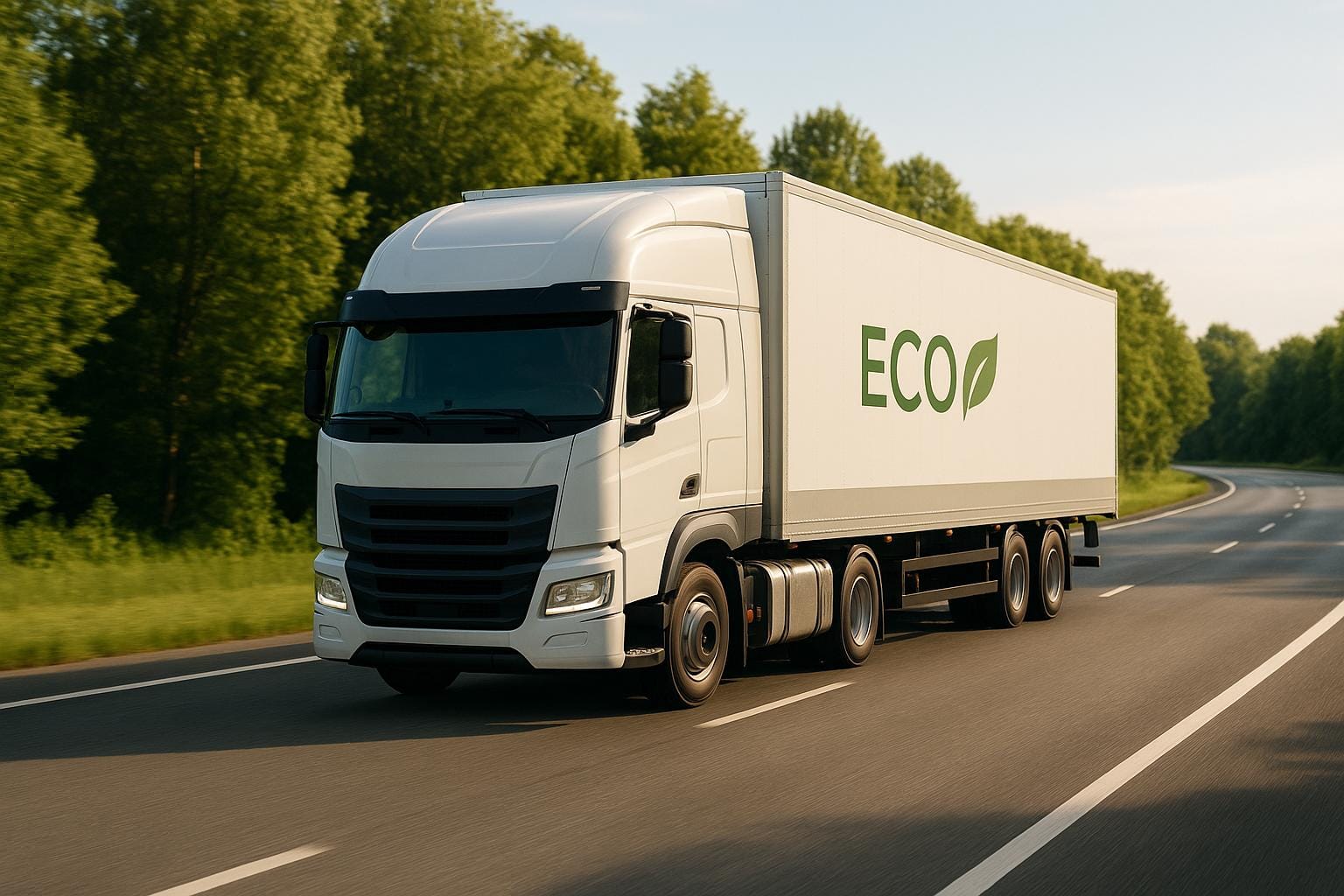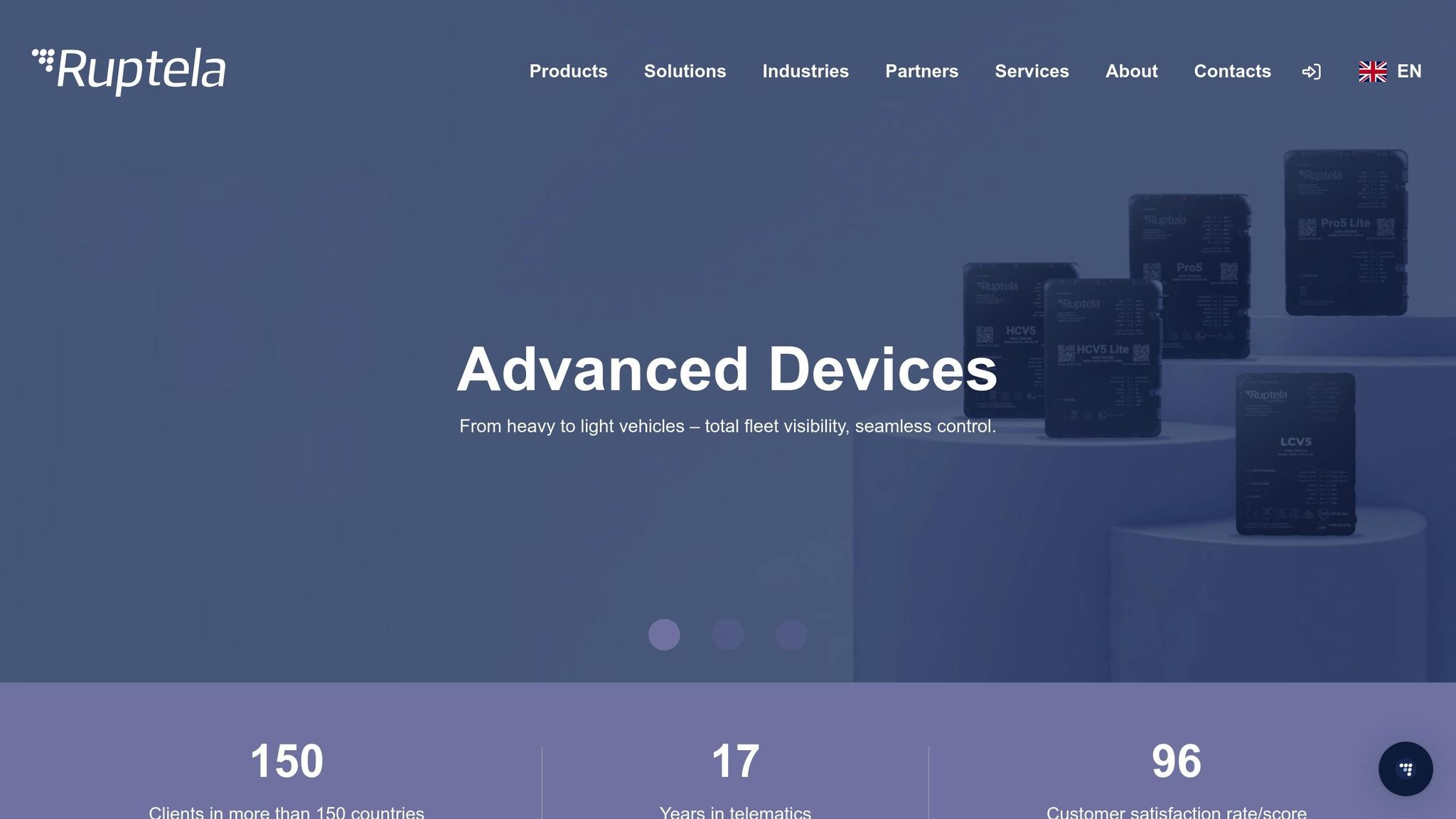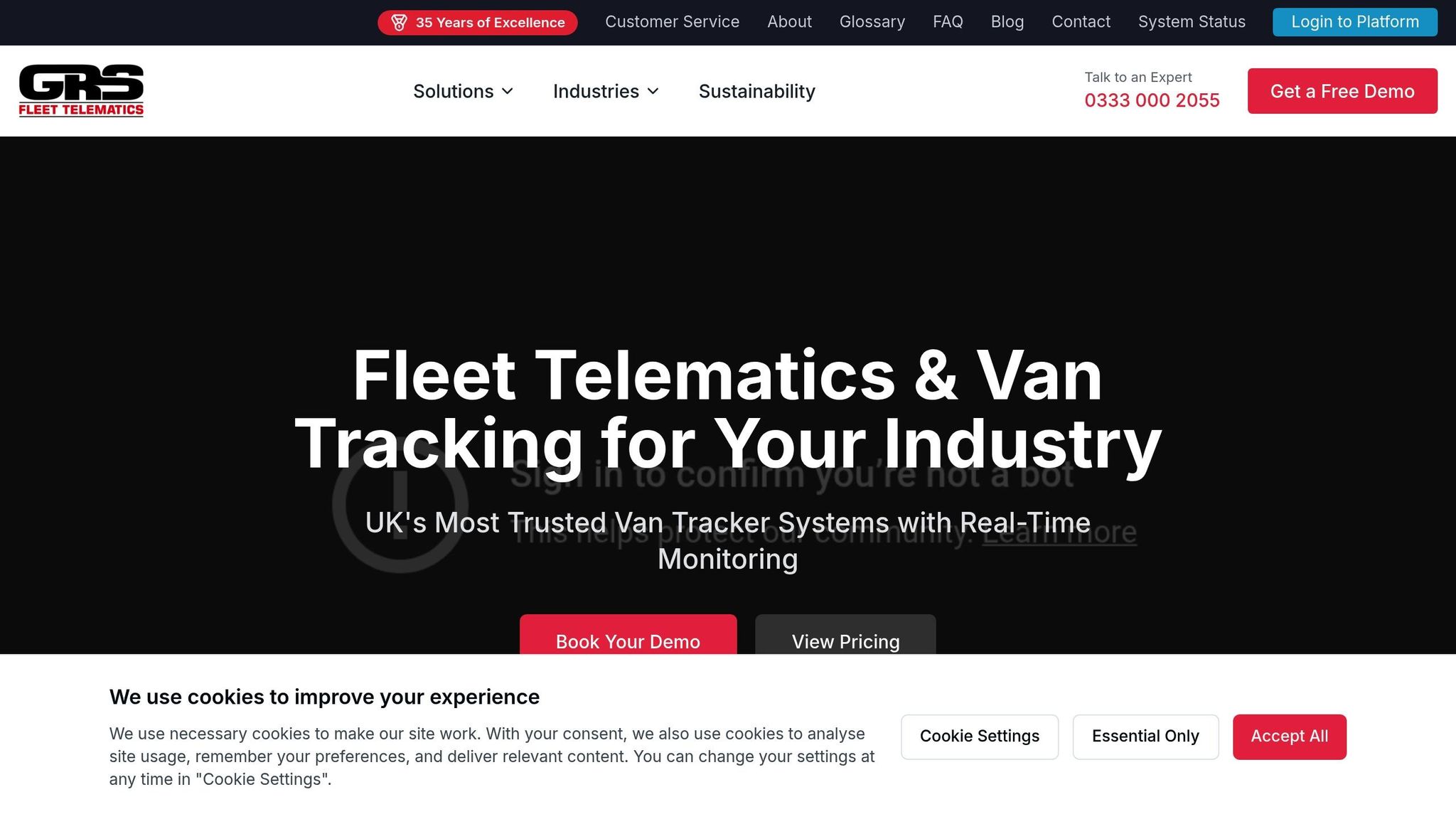How Telematics Supports Eco-Driving Practices
Explore how telematics enhances eco-driving practices, reducing fuel costs and emissions while improving fleet efficiency and safety.

Telematics is transforming how UK fleets manage fuel use and driving habits. By combining real-time data with eco-driving techniques, fleets can cut costs, lower emissions, and improve safety. Here's what you need to know:
- Eco-driving includes smoother acceleration, braking, and reducing idling to save fuel and cut CO₂ emissions.
- Telematics systems monitor driver behaviour, track fuel use, and provide real-time feedback to help drivers improve.
- UK fleets have seen up to a 25% reduction in fuel costs and emissions by adopting telematics and eco-driving.
- Tools like driver scorecards and route optimisation reduce waste, while tailored training boosts long-term results.
Telematics isn't just about saving fuel - it helps businesses meet environmental targets, reduce maintenance costs, and improve overall efficiency. Whether you're managing a small or large fleet, telematics offers measurable benefits that can make a big difference.
Webinar - Eco-Drive solution by Ruptela

Driving Behaviours That Telematics Tracks
Telematics systems monitor driving behaviours that directly influence fuel consumption and fleet performance. Knowing what these systems track - and why it matters - helps fleet managers address inefficient habits and turn them into cost-saving practices.
Smooth Acceleration and Braking
One of the primary focuses of telematics is tracking how drivers accelerate and brake. These systems detect harsh acceleration and sudden braking events, providing detailed data on speed changes. For example, rapid acceleration or aggressive braking can reduce fuel efficiency by 15–30% on motorways and up to 40% in stop-and-go traffic. Additionally, abrupt speed changes can increase fuel use by 20% .
Telematics helps tackle these behaviours by sending real-time alerts when they occur. Fleet managers can use this data to create personalised Driver Scorecards, which highlight fuel efficiency metrics. This allows managers to coach drivers who frequently demonstrate wasteful habits. On the flip side, drivers who consistently practise smooth driving can be rewarded through incentive schemes, promoting better habits across the fleet.
Reducing Idling Time
Excessive idling is a major source of avoidable fuel waste, and telematics systems are designed to monitor and minimise it. These systems track how long vehicles stay stationary with the engine running and notify fleet managers when idling exceeds acceptable limits.
In the UK, idling accounts for 12% of engine run time in commercial vehicles. For heavy-duty trucks, this translates to approximately 4.3 million tonnes of CO₂ emissions annually. On an individual level, idling consumes 0.5 to 1 litre of fuel per hour, with prolonged idling using up to 2 litres per hour and releasing over 5 kg of CO₂.
Cutting down on idling can result in significant savings. For instance, managing idle time effectively can save £116 per vehicle annually. Reducing idling by just 30 minutes per vehicle daily can save thousands of gallons of fuel each year. A practical example is DB Regio Bus, which managed to reduce idling times by 40% within a year, cutting CO₂ emissions by 1,400 tonnes annually.
Maintaining Fuel-Efficient Speeds
Telematics also monitors speed patterns to encourage fuel-efficient driving. These systems track vehicle speeds in real time, comparing them against optimal fuel-efficient ranges. Drivers and fleet managers receive alerts when vehicles exceed these thresholds.
Speeding has a significant impact on fuel consumption. Driving at excessive speeds can lower fuel efficiency by 15–30% on motorways. By promoting consistent speeds, telematics encourages the use of features like cruise control, which helps conserve fuel.
Additionally, telematics analyses traffic and road conditions to help drivers avoid congested routes. By steering clear of frequent stops and starts, fleets can further reduce fuel use .
"Telematics solutions are crucial for organizations seeking to curb fuel costs and enhance overall fleet management. By providing real-time data on vehicle performance, driver behavior this technology not only ensures smoother operations but also aids in strategic decision-making aimed at maximizing fuel efficiency."
How Telematics Improves Driver Performance
Telematics plays a pivotal role in refining driver performance, offering precise feedback and tailored training that directly supports eco-driving practices. By making eco-driving measurable and actionable, telematics helps fleets achieve noticeable savings and improved driving behaviours through tools like real-time feedback, detailed tracking, and structured coaching.
Real-Time Driver Feedback
One standout feature of telematics is its ability to deliver real-time feedback, which is essential for eco-driving. These systems monitor vehicle performance and can instantly notify supervisors about inefficient driving habits, such as harsh acceleration or sudden braking. In-cab alerts act as on-the-spot coaching, giving drivers the opportunity to adjust their behaviour immediately.
Research highlights the benefits of this approach: eco-driving practices supported by real-time feedback can reduce hard-braking incidents by 7%, hard left and right turns by 8% each, and overall collision risk by 4%. Even small adjustments, like a 1% increase in cruise control usage, have been shown to cut hard-braking events by 3%.
"Instantaneous feedback and real-time coaching enabled by telematics and similar technologies are keys to uncovering unsafe driving habits early, and correcting them soon enough to reap the benefits."
- Jason Cannon, Chief Editor, Commercial Carrier Journal
Additionally, real-time tracking aids in route planning by helping drivers avoid traffic congestion, which reduces unnecessary stops and starts. This not only saves fuel but also boosts delivery efficiency. The data gathered is then used to create detailed driver scorecards, forming the basis for targeted coaching.
Driver Scorecards and Reports
Telematics systems generate comprehensive driver scorecards that evaluate performance across various eco-driving metrics. These reports provide crucial insights into driver behaviour, identifying areas for improvement such as speeding, harsh braking, or excessive idling. Fleet managers can pinpoint drivers who need extra training, while drivers themselves can monitor their progress over time.
Driving habits significantly impact fuel efficiency, with behaviour accounting for over 30% of fuel losses. Specific actions like speeding (33%), hard acceleration (25%), idling (20%), hard turns (16%), and hard braking (6%) are major contributors to wasted fuel. By using scorecards to benchmark performance, fleets can develop targeted coaching strategies, which are explored further in the next section.
Driver Training and Coaching
With data from real-time feedback and scorecards, telematics enables highly targeted coaching tailored to individual drivers' needs. Instead of one-size-fits-all training programmes, fleet managers can create personalised improvement plans based on performance data. For example, some drivers may benefit from virtual coaching, while others might require in-person refresher sessions or one-on-one meetings. The integration of dash cams with telematics adds deeper context to driving events, helping coaches understand the root causes of inefficient behaviour.
Structured training programmes can lead to impressive outcomes. A single day of eco-driving training can improve fuel efficiency by 5%, while more comprehensive training and monitoring can result in up to a 10% improvement for combination truck drivers. In certain cases, fuel consumption has dropped by as much as 17.6% compared to pre-training levels.
For example, Upstate Niagara Cooperative combined in-cab telematics coaching with classroom training, boosting their average fuel economy from 5.81 mpg to 6.10 mpg within three months. Similarly, Artur Express introduced a point-based incentive programme focusing on fuel efficiency, safety, and on-time deliveries. Between 2019 and 2022, their fleet’s average fuel economy rose from 6.9 mpg to 7.7 mpg, saving approximately £1.6 million in fuel costs in 2022 alone.
"Driver coaching can address your important fleet goals – fewer preventable collisions, reduced fuel costs, less driver and vehicle downtime, and altogether safer drivers. The only way to accomplish this is to have driving behaviour data. There is no way to change behaviour long-term if you don't know what the behaviours are."
- Zach Crocombe, Senior Business Development Manager, Field Services at GEOTAB
Effective coaching focuses on actionable metrics like gas pedal pressure, speed management, and fuel consumption. By customising interfaces to suit individual drivers’ preferences, telematics systems can enhance engagement and deliver better results.
Benefits of Telematics-Supported Eco-Driving
Telematics isn't just about improving driver habits - it offers tangible financial and operational advantages. For UK fleets, using telematics to support eco-driving goes far beyond just saving fuel. It drives progress in reducing costs, enhancing efficiency, and even extending vehicle life. The numbers back it up: investing in telematics delivers results like lower expenses, better safety, and reduced environmental impact.
Fuel and Cost Savings
One of the most noticeable advantages of telematics-supported eco-driving is cutting fuel costs. Telematics can slash fuel consumption by up to 15%, while reports focusing on eco-driving behaviours can reduce fleet fuel use by as much as 10%. By optimising routes and limiting idling, fleets can achieve fuel savings of up to 20%, directly boosting profitability. For instance, logistics companies using telematics can cut mileage by 10–20%, leading to significant fuel and CO₂ savings. Even tackling specific issues like excessive idling can bring in savings of £116 per vehicle annually.
Efficient route planning and minimising idle time further amplify these savings.
"The return on telematics is quite immediate, maybe about a month. Fleet managers could see 15 to 20% savings on their costs. With this, they can invest in other things for their employees."
– Juan Cardona, VP Sales, Latin America at Geotab
These savings align perfectly with environmental goals, making it a win-win for businesses aiming for both profit and sustainability.
Lower Emissions and Environmental Impact
Telematics also helps fleets tackle growing environmental challenges. By adopting telematics-supported eco-driving, businesses can significantly cut carbon emissions. Fleets using these systems report reductions of several tonnes of CO₂ annually. In fact, eco-driving features can offer tailored guidance that lowers emissions by 20–25%.
Evidence from trials highlights these benefits, and for companies shifting to electric vehicles (EVs), the environmental gains are even greater. Choosing the right EV can result in annual savings of £500 and a reduction of 4 tonnes of CO₂ per vehicle. These dual benefits - cost savings and environmental improvements - enable fleets to meet carbon reduction targets while avoiding penalties under stricter emissions regulations.
"With sustainability a clear priority for physical operations leaders in the UK and Ireland, investing in ways to transform their fleet has never been more important. Connected technologies can play an important role in enabling operations leaders to create a modern, sustainable fleet, providing data that can improve fuel economy, create more efficient vehicle routing, and promote more eco-friendly driver behaviour."
– Philip van der Wilt, SVP and general manager EMEA at Samsara
Reduced Maintenance Costs and Better Safety
Eco-driving powered by telematics fosters smoother driving habits, which, in turn, lowers vehicle wear and tear. This reduces maintenance costs and improves safety. Predictive maintenance, enabled by telematics, can cut maintenance expenses by 5–10%. By addressing issues before they escalate, fleets can avoid costly emergency repairs and minimise downtime.
Safety also takes a leap forward with telematics. Fleets using these systems report a 20–30% drop in accident rates. The technology helps identify and address risky driving behaviours early, preventing incidents before they occur. For example, Day & Nite - a company specialising in commercial refrigeration and HVAC services - reduced rear-end collisions by 75% in just six months by using IntelliShift's AI dash cameras. This not only improved their safety record but also sped up claims processing, cutting accident-related costs and insurance premiums.
Telematics also enables condition-based maintenance, where service schedules are tailored to actual vehicle usage rather than fixed intervals. This avoids unnecessary servicing and keeps vehicles running efficiently.
"Predictive modelling helps you stay ahead of problems. You can see when vehicles are about to break down and schedule services before things escalate. That way, you have parts ready, reduce downtime, and avoid last-minute costly repairs."
– Erin Gilchrist, VP of Fleet Evangelism at IntelliShift
The broad advantages of telematics-supported eco-driving make it a powerful tool for fleets, delivering not just fuel savings but also significant improvements in safety, environmental impact, and operational efficiency.
Setting Up Telematics for Eco-Driving
Turning the idea of fuel savings and reduced emissions into daily habits starts with setting up telematics for eco-driving. This involves choosing the right system, setting clear objectives, and following a structured plan. With the right tools and a solid strategy, UK businesses can improve both fuel efficiency and driver habits.
Choosing the Right Telematics System
The right telematics system should monitor key driving behaviours like harsh acceleration, sudden braking, excessive idling, and speeding. These insights are crucial for promoting eco-friendly driving.
Look for features such as eco-driving analytics to analyse fuel usage, driver scorecards to highlight improvement areas, and customisable reporting tools. Systems that include route optimisation and geofencing alerts - like notifications for specific speed limits or restricted zones - are especially helpful.
Scalability is another important factor. Whether you're managing a small fleet or planning for growth, the system should adapt to your needs. Integration with your current fleet management software can simplify operations, and a transparent pricing model ensures you see measurable returns through fuel savings and operational efficiency.
Setting Goals and Tracking Progress
Start by setting SMART goals (Specific, Measurable, Achievable, Relevant, Time-bound) and focus on key performance indicators (KPIs) like better fuel efficiency, improved driver scores, and less idling. For instance, you might aim to cut fuel consumption by 10% within six months.
Break these goals into smaller, actionable steps for your drivers. If smoother acceleration and braking are the focus, these habits alone can boost fuel efficiency by up to 10%.
Tracking progress regularly keeps the momentum going. Use telematics data to create weekly or monthly reports that highlight changes in driving behaviour. Incentive programmes based on real-time feedback can further encourage eco-driving habits.
Analysing your telematics data frequently can uncover new areas for improvement. For example, reviewing trends might show specific routes that lead to higher fuel usage or times when harsh driving spikes. These insights can guide adjustments to training programmes and operational procedures.
Using GRS Fleet Telematics for Eco-Driving

Once your goals and tracking systems are in place, a dedicated telematics platform can take your eco-driving efforts to the next level.
GRS Fleet Telematics is tailored for UK businesses aiming to adopt greener driving practices. It tracks critical metrics like fuel consumption, idle time, and driving patterns, creating a clear starting point for improvement. The platform also generates eco-driving reports with actionable recommendations specific to your fleet’s needs.
Real-time alerts notify fleet managers of inefficient driving, allowing for immediate coaching and adjustments. GRS Fleet Telematics also integrates carbon offsetting solutions through its partnership with Furthr, helping businesses enhance their environmental efforts.
The system is designed for seamless integration. Flexible hardware options, a monthly subscription of £7.99 per vehicle, and free installation (when paired with fleet branding services) make it accessible. Plus, features like 24/7 support and white-label branding ensure smooth operation within your existing setup.
With potential fuel savings of 5–15%, the investment often pays off within months. Combined with route optimisation and driver coaching, GRS Fleet Telematics equips your fleet with all the tools needed to make eco-driving a sustainable and cost-effective practice.
Conclusion
Telematics is reshaping eco-driving for UK fleets, delivering noticeable benefits in fuel savings, safety, and emissions reductions. UK fleets have reported up to a 25% decrease in fuel costs and CO₂ emissions, proving this technology’s ability to enhance operations while supporting sustainability goals.
Real-world success stories highlight these advantages. Metro Logistics, for instance, reduced its carbon footprint by 34% and saved over £45,000 annually. SES Water saw a 15.1% improvement in miles per gallon and eliminated dangerous driving incidents entirely. As Robert Jenkins, Fleet Manager at Metro Logistics, shared:
"GRS Fleet Telematics has transformed our sustainability efforts...we've cut our carbon footprint by 34% whilst reducing fuel costs by over £45,000 annually."
The benefits extend far beyond fuel savings. UK companies using telematics have achieved a 17% reduction in accident costs, a 20% cut in overall labour expenses, and a 30% drop in unplanned repairs. Transport for London also reported a 15% decrease in journey times across its fleet. Real-time feedback and driver coaching have enabled some businesses to reduce incidents by 88% and damage costs by 78%.
What’s more, the investment in telematics often pays off quickly. With eco-driving analytics starting at just £7.99 per month, tools like GRS Fleet Telematics provide a cost-effective way to monitor fuel efficiency, coach drivers, and generate detailed reports. This creates a comprehensive system for sustainable fleet management.
As UK businesses navigate rising operational costs and increased sustainability demands, telematics offers a practical, measurable solution. It turns eco-driving into a strategic approach that delivers long-term value for fleets of all sizes.
FAQs
How can telematics help UK fleets reduce their environmental impact?
Telematics plays a key role in helping UK fleets lessen their environmental footprint by tracking fuel use, emissions, and driving habits. With this data, businesses can pinpoint ways to reduce fuel consumption and lower carbon emissions, aligning with their environmental goals.
These systems promote eco-friendly driving by cutting down on unnecessary idling, encouraging smoother acceleration and braking, and planning more efficient routes to shorten travel distances. This approach not only benefits the planet but also reduces fuel expenses. On top of that, telematics offers critical insights for moving towards greener fleets, such as preparing for the adoption of electric vehicles or working towards net-zero emissions targets.
What driving habits does telematics monitor to support eco-driving, and how does this improve fuel efficiency?
Telematics systems keep track of important driving behaviours like harsh acceleration, sudden braking, excessive idling, and speeding. By offering real-time feedback and alerts, they encourage drivers to adopt smoother, more fuel-efficient habits behind the wheel.
This kind of immediate guidance not only cuts down on fuel usage but also helps reduce emissions, leading to cost savings and a reduced carbon footprint. Over time, these changes can make operations run more efficiently while supporting eco-friendly driving practices.
How can telematics help businesses in the UK promote eco-driving and reduce costs?
Telematics systems are a powerful tool for encouraging eco-friendly driving by tracking behaviours like speed, idling, and sudden acceleration. With this data, businesses can offer real-time feedback and practical advice to drivers, promoting fuel-efficient habits that could cut fuel consumption by as much as 15%.
Beyond shaping better driving habits, telematics helps streamline routes, reducing unnecessary mileage and ensuring vehicles run more efficiently. It also supports proactive vehicle maintenance by flagging issues early, which not only prevents breakdowns but also boosts fuel efficiency. For UK businesses, adopting telematics is a smart move towards reducing environmental impact while also lowering operational costs.
